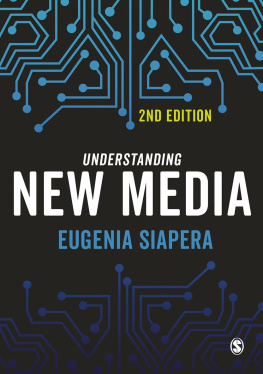Praise for the first edition
Eugenia Siaperas Understanding New Media offers an admirably clear-sighted and engaging analysis of contemporary forms of mediation, illuminating the dynamics of new media across social, political and cultural spheres while skilfully avoiding the many traps that abound in this field of hyperbole, obfuscation, partiality and lack of empirical grounding. She provokes her reader to think afresh about familiar phenomena, to synthesise diverse theoretical positions, and to stretch their imaginations to anticipate what is coming.
Professor Sonia Livingstone
Department of Media and Communication, London School of Economics and Political Science
An excellent introduction to the past, present and future of the electronic, networked media world. By carefully examining the complex interactions between society and media, Siapera insightfully illuminates the social, political, economic and cultural consequences of our increasingly electronically networked and mediated world. This book will be a highly useful teaching tool and an engaging read for students, teachers and scholars.
Steve Jones
University of Illinois, Chicago
SAGE Publications Ltd
1 Olivers Yard
55 City Road
London EC1Y 1SP
SAGE Publications Inc.
2455 Teller Road
Thousand Oaks, California 91320
SAGE Publications India Pvt Ltd
B 1/I 1 Mohan Cooperative Industrial Area
Mathura Road
New Delhi 110 044
SAGE Publications Asia-Pacific Pte Ltd
3 Church Street
#10-04 Samsung Hub
Singapore 049483
Eugenia Siapera 2018
First edition published 2011
Reprinted 2012, 2013, 2014
This second edition published 2018
Apart from any fair dealing for the purposes of research or private study, or criticism or review, as permitted under the Copyright, Designs and Patents Act, 1988, this publication may be reproduced, stored or transmitted in any form, or by any means, only with the prior permission in writing of the publishers, or in the case of reprographic reproduction, in accordance with the terms of licences issued by the Copyright Licensing Agency. Enquiries concerning reproduction outside those terms should be sent to the publishers.
Library of Congress Control Number: 2017942509
British Library Cataloguing in Publication data
A catalogue record for this book is available from the British Library
ISBN 978-1-4462-9709-4
ISBN 978-1-4462-9710-0 (pbk)
Editor: Michael Ainsley
Assistant editor: John Nightingale
Production editor: Imogen Roome
Marketing manager: Lucia Sweet
Cover design: Jen Crisp
Typeset by: C&M Digitals (P) Ltd, Chennai, India
Printed in the UK
Preface
When the first edition of Understanding New Media was conceived, around 2008, the new media landscape was very different. So much so that todays internet users would hardly recognize it. The term social media hadnt yet entered our vocabularies, but the rising importance of these media was already apparent. By the time the book was actually published in 2011 there was another sea of change: this time precipitated by political developments centring on the Tunisian and Egyptian revolutions and the events known as the Arab Spring. At the time of writing this, in late 2015, there are more changes but also consolidation: the power and dominance of Facebook and Google is beyond dispute. Protest, empowerment and participation are still at the forefront, but tempered by increased surveillance, corporate domination, and also by user actions such as shaming, malicious trolling and cyberbullying. In this context of change and consolidation, the challenge is not only to provide up-to-date information and correctly identified trends, but also to develop a specific theoretical and analytical perspective or lens by which to read these developments and trends. There are a lot of new media and technology gurus and futurologists out there, but what this book aspires to is something different: not to predict, but to read, analyse and understand current trends, based on empirical research and social scientific theories, and, at the same time, to offer students an analytical template through which to make sense of the present and future developments in new and social media.
The main aim of this book therefore is to provide a means by which to decipher the complex relationships between technologies, media and social fields. The disciplinary lens used here is social scientific, meaning that priority is given to research that has produced findings on these relationships, using a variety of methods, quantitative and qualitative, and drawing on theories from sociology, psychology, political science, and media studies. Understanding New Media from this point of view involves understanding what research has told us about new media and various fields of life. At the same time, however, research does not speak for itself: it already involves certain assumptions regarding these relationships, assumptions which may come from previous studies or which may develop from the ground up; moreover, it actively interprets findings and data in ways commensurable with these assumptions. Social scientists do not always agree on these assumptions and their validity, nor do they always agree on the interpretation of findings. Mapping these disagreements is also a part of this book. It is in and through these disagreements that the complexity of the issues involved can be made clear.
While the emphasis is on social scientific research, the book is equally concerned with the role of history and with a social historical understanding of new media developments. It is not unusual in social science to proceed as if there is no history, no learning, no building upon previous developments. As if everything is perpetually new. This is occasionally found in new media approaches as well, which tend to focus on innovation and novelty, overlooking continuities and the role of path dependency: often, new developments take place along a path that has opened up some time in the past, and this to an extent shapes and prefigures their present and future. Tracing continuities and understanding the past of current innovations and current media is important, and this book will do this whenever the opportunity arises.
But do we still need to refer to new media, now that the internet has been around for over 46 years (since 1969s ARPANET), the Web for 25 years (since Tim Berners-Lees World Wide Web invention in 1993) and social media at least for 11 years (since Facebooks launch in 2004)? Understanding new media frames these media in very specific terms: to refer to new media even as the internet is already 45 years old and the Web around 25 may raise questions. Why new? Where does the novelty lie? Why not digital or social media? The explains how the various terms have been conceived and applied here. This will be followed by a summary of the key debates that have structured the field of studying the new media, as these will also emerge in various points across the book. The final section here will provide brief summaries for the chapters to follow and a guide to the pedagogical features of the book.















